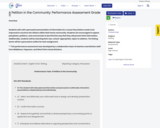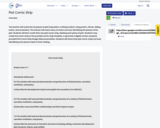
Students write a multi-paragraph persuasive piece by developing their opinion on an issue and providing reasons/evidence that support their topic.
- Subject:
- English
- Writing
- Material Type:
- Assessment
- Author:
- Deb Wilkinson
- Date Added:
- 03/28/2021

Students write a multi-paragraph persuasive piece by developing their opinion on an issue and providing reasons/evidence that support their topic.

Students will craft a persuasive presentation of information for a cause they believe needs to be improved to convince the citizens within their home community. Students are encouraged to explore pamphlets, petitions, and commercials to best find the way that they will present their information. Additionally, students will be selecting their own, school-appropriate, topics to address. The linking factor will be a persuasive outline for each assignment.** This performance assessment was developed by a collaborative team of teachers and division staff from Middlesex, Poquoson, and West Point school divisions.

The Pharmacy Technician FlexBook is a 17 chapter OER textbook curated and created by two Virginia Beach City Public Schools educators, Kim McTyre and Kathleen Vuono, to support the new CTE Pharmacy Technician course.

1. Moon Phases Lesson Plan2. TEI Moon Phases3. Moon Phase Sample

This lesson will help students differentiate between physical and cultural regions as well as categorize regions as either formal, functional, or perceptual. Students will differentiate among the three categories of regions on a Google Worksheet, and students will label a physiographic map of Virginia. (Teachers will need to make a copy of all the Google Docs, Forms, Worksheets, etc. for themselves.)

Sequence Cardiovascular Exercises is a cross-curricular lesson designed by an Elementary Health and PE teacher to support Math and English instruction. Created By: Steve Ellison Powhatan County Public Schools

Picasso vs Van Gogh lesson is a cross-curricular lesson designed by an Elementary Art teacher to support Math instruction. Created By: Heather Kunks Powhatan County Public Schools.

Place integers on the number line. Then write integers in order from greatest to least or least to greatest as requested. Use the number line to help make conceptual connections about positive and negative integers.

The teacher will review the six phases of plot (exposition, inciting incident, rising action, climax, falling action, and resolution). The teacher will read a story of choice out loud, identifying the phases of the plot. Students will then create their own plot comic strip, labeling each phase of plot. Students may create the comic strip on the provided comic strip template, or generate a digital version using the provided Plot Comic Strip Google Slide presentation. Students will share their plot comic strips out loud, identifying each phase of plot in their reading.

This is part of a series of lessons commissioned by the Democracy Project at the University of Virginia centered around the podcast Democracy in Danger.Democracy in Danger lessons share some basic characteristics. In each of these inquiries, the explicit or implicit question is, “What should we do about .. “ because that is an essential question we must ask of all of our citizens. Additionally, Democracy in Danger lessons will lead students through a problem analysis characterized by the 4A approach (assses the problem, analyze the causes and effects of the problem, address potential solutions to the problem, act on a potential solution. We hope to make this type of problem analysis process a routine that young people can transfer to any new challenge that we face in our democracy and that it will pave the way for healthy deliberation with their fellow students, to collaboratively act together, and to forge healthy civic friendships that will strengthen our democracy.

In this group (optional) inquiry lab, students explore the effects of runoff pollution on plants. Part 1 - Observations, Inferences, and Questions*Recommended that the teacher projects the images or prints them in color (if laminated, they can be preserved for future years). In addition, have students work individually first without sharing ideas, then have them share after each section with their group.

In this group (optional) inquiry lab, students explore the effects of runoff pollution on plants. Part 2 - Research*Guiding Questions and Key Provided

In this group (optional) inquiry lab, students explore the effects of runoff pollution on plants. Part 3 - Experimental Design*Sample Provided *Recommended that the students brainstorm types of runoff after their research and each group choose one that is feasible for the classroom environment.

In this group (optional) inquiry lab, students explore the effects of runoff pollution on plants. Part 4 - Write-up*Students use their previous work and data to complete each section of the write-up. They use the guiding documents to construct each part and then can copy them into a single document (provided) or an online journal.

In this group (optional) inquiry lab, students explore the effects of runoff pollution on plants. Rubrics*One rubric can be used for the initial work for the lab, while the other is for the final product (includes self-check before the teacher grades it).

I created the Polygons Sort Jam to give my students practice with polygons vocabulary. Before doing the sort, I have my students practice with drawing polygons and playing games to help learn the names. I also give them a helpful hints page to help them remember the names and sides of the polygons. This activity supports sol 3.12, identify and name polygons with ten or fewer sides.

Students will use a draggable point to investigate intervals of increase and decrease and then practice writing and fining intervals.

This activity is intended as practice for students learning about primary and secondary sources. Students should receive instruction on the differences between primary sources and secondary sources prior to completing this activity. Students will be given a random selection of artifacts. They will be asked to go through the primary source analysis process (adapted from the National Archives) to analyze and make sense of the artifacts. They will create a secondary source about the person represented by the artifacts.

Practice for level 1 students with the alphabet in French. Students will watch a video and complete activities working with cognates.

Students are working to practice numbers 1-10 by simulating exchanging phone numbers.